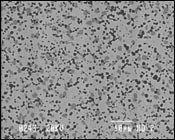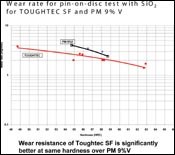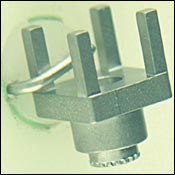Take ‘Em for a Spin
Need fast, reliable deburring of small parts?
The proliferation of automated metal cutting equipment such as CNC milling and turning machines, coupled with automatic feeding capability, high spindle speeds and sophisticated micro-tooling, has driven continuing increases in machining productivity despite the complex geometries of many parts. Driven by miniaturization and labor saving features, development of these new machining systems has dramatically lowered manufacturing costs by enabling production of more parts with less labor input.
Unfortunately, many manufacturers that have implemented such systems see production savings offset by outmoded deburring practices. It may be hard to believe, but there are still shops that have high-paid employees looking through microscopes and using hand tools such as X-Act-O knifes to deburr small parts. Whatever savings were realized in machining—and any potential profits—are lost because old habits still die hard and because many shops don’t put any thought into how they will deburr all the parts their new machining systems produce.
On the other hand, some machine shops have discovered and are using small, self-contained high-speed mass deburring equipment that is ideal for the cellular deburring of parts. These companies are quoting jobs more competitively and improving their profit margins on jobs they do win.
Stiff Competition
Reliable, cost-effective deburring is becoming more and more important as quality and delivery demands from customers and potential customers continue to escalate. Parts manufacturers now cope with a situation where the per-piece size of orders for parts is smaller and the capability to provide rapid delivery is the price of entry into the market. Materials being machined are becoming more sophisticated, with greater use of many new superalloys, titanium alloys and stainless steels. Smart shop owners have made the investment in machining equipment and sharpened their skills in machining these materials, yet many continue to neglect making improvements in the deburring process.
This is actually understandable. The machining process is normally the primary focus of engineering efforts to contain manufacturing costs. Seldom does the deburring process enter into strategic up-front planning on how to keep costs to a minimum. Many times I have seen companies that have invested large sums of money in tooling systems and, in some instances, new and expensive equipment that ranges from $150,000 to $500,000, while giving little or no consideration to how they will deburr the products to get them out the door. Often, a company will begin producing parts only to realize that a particular machined work piece requires more labor for deburring than was needed for manufacturing.
When a company has to backtrack and try to solve the problem of deburring, its initial planning and costing is completely disrupted. Changing the machining process or attempting to utilize a secondary tool to remove burrs usually results in longer cycle time on the machining center and provides a poor solution for a problem that could have been avoided with some up-front thought and planning.
One solution to the problem of deburring quantities of small, complex components without labor-intensive hand operations is small-scale centrifugal disc finishing. Such systems are compact, easy to use, and as self-contained units are very practical for cellular manufacturing setups. This ability to fit into an automated process after machining is important to maximize labor savings, improve process control and deliver fast turnaround times.
Many manufacturers are still set up with a separate department dedicated to deburring, either by hand or using equipment such as vibratory finishing, tumbling, or some other mass finishing process. Parts are funneled into this finishing department from various machines or departments throughout the plant, and enter another phase of the production operation with its own separate controls and production scheduling.
Some shops are able to make this system work; others find it creates bottlenecks in their delivery schedule. Incorporating centrifugal disc finishing systems into the manufacturing process can provide meaningful savings on direct labor while greatly improving process control and delivery time.
Centrifugal Disc Technology
The major advantages of centrifugal disc finishing emanate from the introduction of centrifugal force to the deburring media. This allows the use of very small media, which normally does not perform well in vibratory or tumbling machines. The very small media, with great force behind it, reaches into places on parts normally untouchable by traditional means. Deburring cycle times are drastically reduced because of the force generated in the disc-finishing machine.
Centrifugal disc technology uses a bowl-shaped finishing chamber with two basic components: a solid, fixed upper bowl and a spinning bottom disc. The disc is rotated, which in turn spins the media and parts and forces the mass to the stationary outside wall of the bowl with centrifugal force. The mass of media then folds back down into the center of the bowl, and the cycle is repeated.
The result is a three-dimensional toroidal action similar to that in a vibratory bowl finisher, except much tighter and with much more force. The chamber is always open, and work parts are very accessible to the operator for inspection.
Water and compound flow through the open chamber to provide constant flushing and keep both media and parts clean. By adjusting the speed of the rotating disc, the force introduced to the mass can be varied from soft to very aggressive and therefore allow control of your finishing operation.
There are two basic styles of centrifugal disc finishers: those with what is termed a north/south gap system, and those with an east/west gap system. The gap is the point of the machine between the rotating disc and the fixed finishing chamber.
The key to the function of a disc finisher is based on the design of the gap system, because this is the point of the machine that will experience the most wear. Process effluent, which contains the breakdown of the media, small fines from the work pieces and the water/compound solution of the process, flows through this gap.
Maintaining the accuracy of the gap system is the key to finishing effectiveness. Typical gaps range from 0.004 to 0.032 in.; the closer the tolerance, the more precise the finishing process can be.
Most centrifugal disc machines are made with an east/west gap system. As the spinner disc wears over time, it is reduced in diameter. This has the effect of increasing the size of the gap until the spinner disc must be relined or replaced. Machines with a north/south gap are made to be adjusted as wear increases the gap, allowing greater process control and longer machine service life.
Centrifugal disc deburring works well with delicate parts, using a combination of small media and adjustable force to eliminate hand deburring operations and save time and money. Even in applications where parts cannot be completely finished in the disc finishing equipment, the process can often eliminate 80% of the hand work, effectively allowing hand deburring operations to produce five times the original output.
Centrifugal disc finishing is excellent for deburring of small to medium-size work pieces with intricate details. Parts that have configurations that would preclude deburring using a conventional mass finishing process are often attainable with disc finishing. Inside bores and intersecting cross holes still remain a problem for any mass finishing method, and work pieces that are longer than half the diameter of the bowl are also not good candidates for this type equipment.
So how does centrifugal disc finishing stack up against other mass finishing technologies? Here’s a brief review of the advantages and limitations of some other typical processes.
Vibratory finishers have open containers and allow for a flow-through compound operation. Cycle times generally range from four to ten times longer than those typical of centrifugal disc finishing. Small media are ineffective due to the lack of centrifugal force.
Centrifugal barrel finishers have closed containers which do not allow flow of compounds. Barrels can generate the highest forces of any type of mass finisher, and allow for parts to be individually compartmentalized; however, loading and unloading are relatively labor-intensive. Finishing action is two-dimensional, which can sometimes produce part-on-part impingement and damage delicate work pieces.
Cellular Processing
As previously stated, compact centrifugal disc finishing systems also lend themselves to cellular configuration, enabling important labor savings. Typical deburring cycles range from 5 to 30 min, with a load/unload labor time of five minutes. Deburring can often be performed by an employee responsible loading and unloading the machining center producing the parts, eliminating an additional labor cost.
Even in companies that maintain a central deburring department, centrifugal disc finishing can play an important role. In many cases, these departments are equipped with large machines made to handle very high throughputs or relatively large work pieces. Smaller orders are either put into a queue or are processed in a machine that is much too large for the batch size. Compact centrifugal disc machines can facilitate fast turnarounds on small batches of parts, helping users meet tight delivery schedules and allowing larger pieces of equipment to be used to their capacity.
Current centrifugal disc finishers are modular in construction, which facilitates their use in decentralized or cellular deburring applications. Machines can be constructed with one, two, three or even four process chambers of a variety sizes. They can be set up for multiple types of processing such as deburring and/or polishing. Machines can be configured and sized to match the output of an adjacent machining center. Simple closed-loop water treatment systems can be coupled with disc finishers and even placed on a mobile platform that can be wheeled from machine to machine to maximize flexibility. Total system footprint can range between 15 and 30 sq ft.
Polishing operations can also be performed with the same equipment setup. Although it may not be important to the performance of the parts being produced, it can be to the user’s advantage to offer a component that is cosmetically more attractive than parts produced by a competitor.
To stay competitive in manufacturing today, companies need to consider every technology and management technique that may provide them with an edge. When manufacturers look at the total production picture, they often begin to realize that a complete operating deburring operation, tailored in size to their specific needs, can give them a leg up on the competition.
Read Next
Education Bringing Cleaning to Machining
Debuting new speakers and cleaning technology content during this half-day workshop co-located with IMTS 2024.
Read MoreA ‘Clean’ Agenda Offers Unique Presentations in Chicago
The 2024 Parts Cleaning Conference, co-located with the International Manufacturing Technology Show, includes presentations by several speakers who are new to the conference and topics that have not been covered in past editions of this event.
Read MoreEpisode 45: An Interview with Chandler Mancuso, MacDermid Envio Solutions
Chandler Mancuso, technical director with MacDermid Envio discusses updating your wastewater treatment system and implementing materials recycling solutions to increase efficiencies, control costs and reduce environmental impact.
Read More
















.jpg;maxWidth=300;quality=90)








